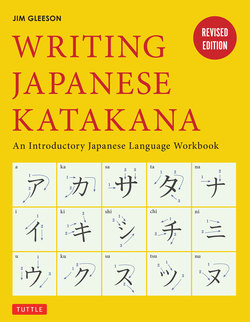Читать книгу Writing Japanese Katakana - Jim Gleeson - Страница 7
На сайте Литреса книга снята с продажи.
ОглавлениеHow to Use This Book
ツカィカタ
In both printed and handwritten Japanese, the characters occupy imaginary squares of equal size, with each character centered within its square.
All of the writing practice in this book involves writing characters within squares, and the squares have centerlines to provide the correct balance and feel for writing Japanese.
Traditionally, Japanese is written with a brush or fude, and this fact is reflected in many typographic styles today. Although the fude is no longer widely used, some principles of using a fude still apply to writing Japanese with a pencil or ballpoint pen — in particular, the stroke endings.
The strokes of Japanese characters terminate in one of three ways, as illustrated below.
i) Jumping, to produce a hook at the end of the stroke. This ending is called hane, from the verb haneru, to jump.
ii) Bringing the pen or pencil to a stop while it is on the page. This ending is called tome, from the verb tomeru, to stop.
iii) Lifting the pen or pencil off the page while it is moving. This ending is called harai, meaning ‘sweep.’
When tracing over the characters, be sure to keep these three types of stroke endings in mind, observing how the strokes of the gray-tinted characters terminate.
In Japanese, as in English, there are many differences between handwritten and typeset characters. To enable students to gain the correct feel for written Japanese, educators in Japan have developed a neutral typeface which incorporates the features of handwritten Japanese without the stylistic idiosyncracies of any individual.
This typeface is known simply as Schoolbook or Kyokasho, and is the standard typeface used to teach Japanese schoolchildren the written language. All of the practice characters in this book are set in Kyokasho.
To provide familiarity with a range of type variations, each character entry in this book is accompanied by four different character styles, as shown below. These variations are included for recognition only.
The upper left variation is a bold Mincho typeface while the upper right variation is a bold Gothic typeface. Typefaces of this kind are frequently used in advertisements and newspaper headlines.
The lower left typeface simulates the characters written with a ballpoint pen, while the lower right typeface is a thin brush script indicative of that used on traditional occasions.
